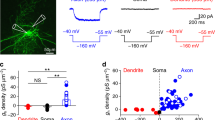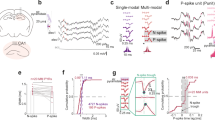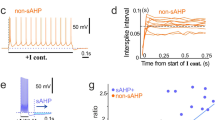Abstract
Integration of membrane-potential changes is traditionally reserved for neuronal somatodendritic compartments. Axons are typically considered to transmit reliably the result of this integration, the action potential1, to nerve terminals2,3. By recording from pairs of pyramidal cells in hippocampal slice cultures4,5,6, we show here that the propagation of action potentials to nerve terminals is impaired if presynaptic action potentials are preceded by brief or tonic hyperpolarization. Action-potential propagation fails only when the presynaptic action potential is triggered within the first 15–20 ms of a depolarizing step from hyperpolarized potentials; action-potential propagation failures are blocked when presynaptic cells are impaled with electrodes containing 4-aminopyridine, indicating that a fast-inactivating, A-type K+ conductance is involved. Propagation failed between some, but not all, of the postsynaptic cells contacted by a single presynaptic cell, suggesting that the presynaptic action potentials failed at axonal branch points. We conclude that the physiological activation of an IA-like potassium conductance can locally block propagation of presynaptic action potentials in axons of the central nervous system. Thus axons do not always behave as simple electrical cables: their capacity to transmit action potentials is determined by a time-dependent integration of recent membrane-potential changes.
This is a preview of subscription content, access via your institution
Access options
Subscribe to this journal
Receive 51 print issues and online access
$199.00 per year
only $3.90 per issue
Buy this article
- Purchase on Springer Link
- Instant access to full article PDF
Prices may be subject to local taxes which are calculated during checkout




Similar content being viewed by others
References
Eccles, J. C. The Physiology of Synapses(Springer, Berlin, (1964).
Mackenzie, P. J., Umemiya, M. & Murphy, T. H. Ca2+ imaging of CNS axons in culture indicates reliable coupling between single action potentials and distal functional release sites. Neuron 16, 783–795 (1996).
Lüscher, C., Streit, J., Quadroni, R. & Lüscher, H.-R. Action potential propagation through embryonic dorsal root ganglion cells in culture. I. Influence of the cell morphology on propagation properties. J. Neurophysiol. 72, 622–633 (1994).
Debanne, D., Guérineau, N. C., Gähwiler, B. H. & Thompson, S. M. Physiology and pharmacology of unitary synaptic connections between pairs of cells in areas CA3 and CA1 of rat hippocampal slice cultures. J. Neurophysiol. 73, 1282–1294 (1995).
Debanne, D., Guérineau, N. C., Gähwiler, B. H. & Thompson, S. M. Paired-pulse facilitation and depression at unitary synapses in rat hippocampus: quantal fluctuation affects subsequent release. J. Physiol. (Lond.) 491, 163–176 (1996).
Gähwiler, B. H. Organotypic monolayer cultures of nervous tissue. J. Neurosci. Meth. 4, 329–342 (1981).
Vincent, P. & Marty, A. Fluctuations in inhibitory postsynaptic currents in Purkinje cells from rat cerebellar slices. J. Physiol. (Lond.) 494, 183–199 (1996).
Frotscher, M. & Gähwiler, B. H. Synaptic organization of intracellularly stained CA3 pyramidal neurons in slice cultures of rat hippocampus. Neuroscience 24, 541–551 (1988).
Stuart, G. J. & Sakmann, B. Active propagation of somatic action potentials into neocortical pyramidal cell dendrites. Nature 367, 69–72 (1994).
Colbert, C. M. & Johnston, D. Axonal action-potential initiation and Na+ channel densities in the soma and axon initial segment of subicular pyramidal neurons. J. Neurosci. 16, 6676–6686 (1996).
Bossu, J.-L., Capogna, M., Debanne, D., McKinney, R. A. & Gähwiler, B. H. Somatic voltage-gated potassium currents of rat hippocampal pyramidal cells in organotypic slice cultures. J. Physiol. (Lond.) 495, 367–381 (1996).
Stephens, G. J., Garratt, J. C., Robertson, B. & Owen, D. G. On the mechanism of 4-aminopyridine action on the cloned mouse brain potassium channel mKv1.1. J. Physiol. (Lond.) 477, 187–196 (1994).
Storm, J. F. Potassium currents in hippocampal pyramidal cells. Progr. Brain. Res. 83, 161–187 (1990).
Segev, I. Computer study of presynaptic inhibition controlling the spread of action potentials into axonal terminals. J. Neurophysiol. 63, 987–998 (1990).
Parnas, I. Differential block at high frequency of branches of a single axon innervating two muscles. J. Neurophysiol. 35, 903–914 (1972).
Parnas, I., Hochstein, S. & Parnas, H. Theoretical analysis of parameters leading to frequency modulation along an inhomogeneous axon. J. Neurophysiol. 39, 909–923 (1976).
Li, X.-G., Somogyi, P., Ylinen, A. & Buzsáki, G. The hippocampal CA3 network: an in vivo intracellular labeling study. J. Comp. Neurol. 339, 181–208 (1994).
Sheng, M., Tsaur, M.-L., Jan, Y. N. & Jan, L. Y. Subcellular segregation of two A-type K+ channel proteins in rat central neurons. Neuron 9, 271–284 (1992).
Kocsis, J. D., Gordon, T. R. & Waxman, S. G. Mammalian optic nerve fibers display two pharmacologically distinct potassium channels. Brain Res. 383, 357–361 (1986).
Storm, J. F. & Lipowsky, R. Evidence that excitability changes in presynaptic fibers may affect paired-pulse facilitation in hippocampal slices. Soc. Neurosci. Abstr. 20, 1339 (1994).
Wall, P. D. Do nerve impulses penetrate terminal arborizations? A pre-presynaptic control mechanism. Trends Neurosci. 18, 99–103 (1995).
Acknowledgements
We thank L. Heeb and L. Rietschin for technical assistance, and A. Marty, J.-C. Poncer, B. Sakmann and S. Tyc-Dumont for critically reading the manuscript. Supported by the Dr.Eric Slack-Gyr and Swiss National Science Foundations. Parts of these data were presented to the American Society for Neuroscience in 1996.
Author information
Authors and Affiliations
Corresponding author
Rights and permissions
About this article
Cite this article
Debanne, D., Guérineau, N., Gähwiler, B. et al. Action-potential propagation gated by an axonal IA-like K+ conductance in hippocampus. Nature 389, 286–289 (1997). https://doi.org/10.1038/38502
Received:
Accepted:
Issue Date:
DOI: https://doi.org/10.1038/38502
This article is cited by
-
A presynaptic source drives differing levels of surround suppression in two mouse retinal ganglion cell types
Nature Communications (2024)
-
Molecular and cellular correlates in Kv channel clustering: entropy-based regulation of cluster ion channel density
Scientific Reports (2020)
-
Modulation of K+ channel N-type inactivation by sulfhydration through hydrogen sulfide and polysulfides
Pflügers Archiv - European Journal of Physiology (2019)
-
The metabolic role of vagal afferent innervation
Nature Reviews Gastroenterology & Hepatology (2018)
-
Electrical Identification and Selective Microstimulation of Neuronal Compartments Based on Features of Extracellular Action Potentials
Scientific Reports (2016)
Comments
By submitting a comment you agree to abide by our Terms and Community Guidelines. If you find something abusive or that does not comply with our terms or guidelines please flag it as inappropriate.



